| Bouchot navigation page, Preface, Chapter 1, Chapter 2, Chapter 3, Chapter 4, Chapter 5, Chapter 6, Chapter 7, Chapter 9, Index |
CHAPTER VIII.
BOOKBINDING.
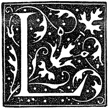 EADING the reader now towards the final perfection of the Book : printing, which had stirred up and reversed so many things, created, so to speak, the art of binding. Previously the binder was simply a workman sewing together the leaves of a manuscript, with no science or device but to clasp the whole together solidly with cord and string. As luxury increased the old binder was no longer thought of. On the wooden boards which closed the Book, jewellers encrusted their wares, lavishing ivory and precious stones to the taste of the amateur or the bookseller. Generally these works covered books of precious miniatures, the Horæ, or manuscripts that were deemed / p.254 / worthy of such magnificent clothing, rarely copies without importance. Printing at once disordered the tribe of copyists as well as the binders did jewellers. The demand increasing, rich bindings were soon abandoned, and each bookseller applied himself to the work, or at least covered in his own house books intended for sale. The fashion was not then to expose for sale, as now, unbound books. Purchasers wanted an article easy to handle, and which they were not obliged to return for ulterior embellishment.
EADING the reader now towards the final perfection of the Book : printing, which had stirred up and reversed so many things, created, so to speak, the art of binding. Previously the binder was simply a workman sewing together the leaves of a manuscript, with no science or device but to clasp the whole together solidly with cord and string. As luxury increased the old binder was no longer thought of. On the wooden boards which closed the Book, jewellers encrusted their wares, lavishing ivory and precious stones to the taste of the amateur or the bookseller. Generally these works covered books of precious miniatures, the Horæ, or manuscripts that were deemed / p.254 / worthy of such magnificent clothing, rarely copies without importance. Printing at once disordered the tribe of copyists as well as the binders did jewellers. The demand increasing, rich bindings were soon abandoned, and each bookseller applied himself to the work, or at least covered in his own house books intended for sale. The fashion was not then to expose for sale, as now, unbound books. Purchasers wanted an article easy to handle, and which they were not obliged to return for ulterior embellishment.So to the public were presented the works laboriously composed by Gutenberg, Schoeffer, and Fust, somewhat after the manner of manuscripts, which they pretended to imitate, with their solid wooden boards covered with pig or calfskin. At the four corners, copper nails, with large heads, prevented rubbing against the shelves of the bookcase, for at that time books were ranged on their sides, and not as they are to-day. We must return to the bibliomaniac of the "Ship of Fools" to get an idea of these depositories ; before him may be seen ranged on a desk large folios, with nails on their sides, in the shelves, so defying the dust, in place of being placed upright on their edges, which rendered them liable to spots and stains. (See fig. 23.)
Unhappily the wooden sides had in themselves a germ of destruction, the worm, capable first of reducing the sides to powder and then ravaging the body of the work, the ligatures and cords. Certain preparations destroy the insect, but the precaution often has no effect, and it is thus that the disappearance of volumes formerly so abundant, but almost impossible to find now, may be explained.
From the beginning the operations of the binder were what they still are, except for improvements. They consist in the collation of the sheets of a book, folding them, beating them to bring them together and give them cohesion, and sewing them, first together, then on
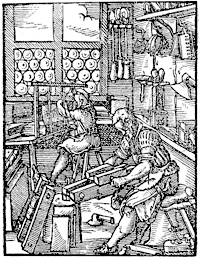
the cords or strings, which form the five or six bands seen on the backs. Primitively these cords were united to the wooden boards, and over both was placed a resistant skin, on which from relief or metal engravings were struck the most pleasing decorative subjects. Pigskin, white and fine, lent itself, especially among / p.256 / the Germans, to these fine editions ; and although they were issued in great number, the wooden boards have not permitted them all to exist in our time.
The most ancient that we are able to cite are German works of the time of Louis XI. ; they are very strong and coarse. The cords in them form an enormous and massive projection. The inside of the board was often without lining of paper or stuff. In the case of fine editions a sombre velvet was sometimes used, such as Verard used to bind the books of the father of Francis I., as we have before said.
Art did not enter into these works of preservation until about the end of the fifteenth century, with arms and emblems. At the beginning of the sixteenth century, some bindings were ornamented for Louis XII. and the Queen, Anne de Bretagne ; but not more than five or six specimens remain. They are of coarse aspect. The workman who tooled the binding here reproduced from the curious example of M. Dutuit, of Rouen, has thrown his subjects one upon another. Arms, porcupines, ermines, are treated so as to be confusing, and form a medley that is not pleasing. In recalling the delightful borders of Vostre and Pigouchet, contemporaries of this mediocre work, it is astonishing to see the degree of inferiority reached by a profession that should be inspired by graceful subjects of decoration.
It happened that France again found in Italy masters capable of revealing secrets of composition and arrangement to enable her to strike out a new road. The Italian wars would not have had these artistic results if it had not been for the enormous sums that they swallowed up. The curious part of the enterprise was that a / JEAN GROLIER. p.257 / war treasurer, a financier, employed by the French
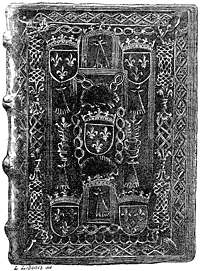
kings in these expeditions, through his relations of taste and friendship with the Alduses of Venice, brought / p.258 / to France the love of sumptuous bindings, of editions superbly clothed. He was named Jean Grolier, that bibliophile of the sixteenth century, who was, above all others, even King Francis, the first to appreciate the art of binding. It is not too much to say art, for if better had not been done before, it may safely be said that nothing better has been done since ; and the books of Grolier remain as the most perfect and most admirable types of this kind of decoration.
Born of an Italian family established at Lyons, where most of his relatives did a great business, Jean Grolier had the good fortune to succeed his father, Stephen Grolier, treasurer of the Duke of Milan. He became in his turn Minister of Finances, and was called to accompany the kings in their expeditions in Italy. The situation of the treasurers during these campaigns was important ; they handled the pence levied with great trouble in the cities of France "for making war." Many abused their trust, and were punished, and among others the Lallemants, whom documents show us to have been in connection with Grolier, and who suffered, with Semblançay, the most terrible trials of the time.
Italian art gave then a free course in the decoration of books. Of the interior we have spoken in our first chapters on the wood engravings ; for the exterior, the cover of the volume, foliage, golden flowers worked with a hot iron, and polychromatic compartments obtained by coloured pastes were multiplied. Thus was produced on the outside that which it was not sought to obtain on the inside, the variation of tints so select among the Italians, and so forsaken since the invention of printing. In the midst of these literary men was a / MAIOLI AND GROLIER. p.259 / lover of books and fine connoisseur who, not content with choosing the best editions, such as those of Ferrara, Venice, and Basle, bound them superbly, with compartments of admirable tone, and had his name and device inscribed on the sides in the fashion of the time. He was named Thomas Maioli, and following the custom of the amateurs of the time, he offered the enjoyment of his library to his friends. " Tho. Maioli et amicorum," he inscribed, as did later Grolier, as also did others, but he somewhat modified the enthusiasm of his friendship by a sceptical device, " Ingratis servire nephas," which might very well be the cry of the owner of books betrayed by his borrowers.
Maioli did not alone use these devices ; he had also a macaronic phrase of which the sense is not very clear : " Inimici mei mea michi, non me michi." He also sometimes used his monogram, which was composed of all the letters of his name.
The relations of Grolier with this unknown and mysterious bibliophile, whose name is not always found outside his volumes, are not doubtful. Brunet possessed a volume that had belonged to Maioli and had passed through the hands of Grolier. What better proof could be wished of the communion of ideas and tastes between the two collectors ?
But these amateurs were not alone. Beside them were princes and great lords, lay and ecclesiastic. From the commencement of the sixteenth century bookbinding had received an enormous impulse from the tastes and the predilections for these lofty fancies. And it cannot be ascribed to the simple skill of the / p.260 / workmen experimenting in that line. In the century that saw Italian artists occupied in making designs for mounted plates and painting beautiful ladies, the courtesans of Venice could not be alarmed at finding them painting models for bindings, with compartments of varied tone and style. Maioli affected white on a dark background, that is to say on a background of dark leather. He made scrolls of foliage in white or clear paste with a very happy effect.
This was the time when Grolier travelled in Italy, in the suite of the French, and when he began his collections. He had adopted as his heraldic emblem the gooseberry bush, which in French came very near to his name — groseillier ; and his motto was " Nec herba nec arbor" (" Neither tree nor herb"), explicative of the moderation of his wealth. He was soon in connection with the Alduses, and through them with the principal learned men and binders of the time, for it was not in the offices of the Manutiuses that could be found workmen, like those of the Chamber of Accounts in France, obliged to swear that they did not know how to read. The master was not hindered by details of difference of language, and it followed that his workmen understood Greek and Latin, for he often gave them instruction in those languages. How far off these erudite and conscientious workmen appear to-day !
Following the fashion, Grolier put his name on the upper side of his books—" Jo. Grolierii et amicorum"—in gold letters, and on the other side a pious motto, the sense of which was a hope often uttered by the financiers of the sixteenth century, imprisoned and hung every instant : " Portio mea, Domine, sit in terra / GROLIER'S BINDINGS. p.261 / viventium." Generally all the Grolier books which came from the Alduses have the name on the upper side and the motto on the other side ; the title was placed above the name, and often disposed in rows. Some large volumes had the cover ornamented with an architectural design, like the Jamblichus of the Libri collection, which had on the front the façade of a temple, with the title in rows on the door. This volume was printed by Aldus in 1516, and probably decorated by him for the account of the great French amateur.
Jean Grolier is said to have himself designed some of the subjects of his ornaments, and their perfection indicates an active and enlightened supervision. On his return to France, where he had a house near the Porte de Bucy, he was put in relation with Geoffroy Tory, the artist best fitted to understand him, and who was at once painter, engraver, printer, and binder. It was there that, in the leisure of his financial functions, between two projects of revictualling the forts of Outre Seine and Yonne, Grolier invented combinations, sought interlacings, and laid out foliage. Tory himself teaches us these works in combination. He invented antique letters for Grolier, he tells us in his Champfleury. It was for him, too, that he interwove so finely his compartments for binding, and that he reproduced the delightful ornaments of his books of hours in golden scrolls.
As we have said, Grolier placed his titles on the sides of his books on account of the arrangement of the works on the shelves of the library where they were laid. For this reason also the back was neglected, and no ornament used upon it ; thick and heavy with its / p.262 / projecting bands, without decoration between the bands, this part of the bound volume was a kind of waste in a splendidly cultivated garden. The profusion of books brought about a revolution. There was no longer room to place on their sides the innumerable books that were produced ; they were then placed on their edges, as now, and the back also was decorated. For this the bands were made to disappear, and replaced by decorative subjects in compartments like the sides. Then with Grolier the bands reappeared, and the title was placed between them, as it still is.
The books of Grolier have been divided, according to their production, in four or five principal classes, in which they may always be placed. First were the works ornamented in compartments, gilt, with scrolls in full gold ; then the same with the scrolls azurés, that is to say equally gilt, but having parallel lines like the azure of heraldry. Following comes the school of Geoffroy Tory, with gilt compartments in the style of the great French decorator ; last the polychromatic bindings, in which, by the aid of colour or mastic, the alternating tones are mixed. Grolier also had some mosaic bindings, composed of little pieces of leather connected by incrustation or paste, pure Italian bindings ; but these were not numerous, especially if compared with those conceived in the manner of Geoffroy Tory.
One of these latter works is here reproduced from one of the beautiful books in the collection of M. Dutuit. This copy has the back flat, and the interlacings of the decoration are most complicated and clever.
Grolier got his Levant moroccos through the dealers
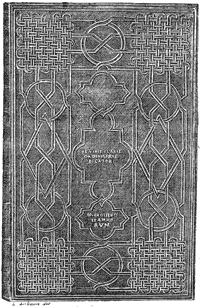
of Venice, to make sure of the material he employed.
Born in 1479, the Treasurer-general of Outre Seine lived until 1565. In 1563 an original manuscript shows him much occupied with finance at over eighty-four years of age ; but his passion for bindings had cooled down, for few books signed with his name are found the manufacture of which could descend to the son of Henri II. After great trials, after having seen Semblançay suffer at Montfaucon, John Lallemand beheaded, and himself having come nearly to losing life and fortune at one blow, Grolier passed away quietly in his house, having collected most of the fine books of the time and many curious medals. Christopher de Thou, his friend and confrère in the love of books, had saved his reputation before the Parliament of Paris. After his death his library was transported to the Hotel de Vic, and from there dispersed in 1675, a hundred years after.
Thus from Italian art came French binding, still remaining original. The kings did not fail to follow the movement, and even to anticipate it, thanks to the means at their disposal. We have seen Francis I. at work with the energy of an artisan at least ; but Geoffroy Tory was his principal inspirer, and who knows but that he was the chief operative for the prince, as for the great financier ?
We have said that Louis XII. knew nothing of fine bindings. During his travels in Italy he had received presentation copies of magnificently covered books, and among others that of Faustus Andrelinus, that was bound in calf in honour of the King. He, who was so little expert in fine arts, purchased the entire library of
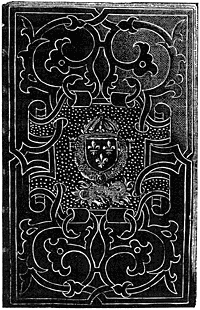
the Sire de la Gruthuse, and substituted his own emblems for those of the high and mighty lord. Francis I., with innate sentiment for masterpieces and the powerful protection he had given them, did not allow the experi-
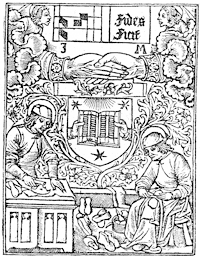
ments of Grolier to pass unnoticed. The King did not desire to be behind the treasurer, and the workmen were put to the task. He adopted the salamander, which emblem he used on his castles and furniture
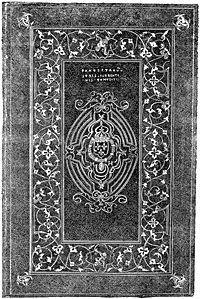
and the liveries of his people ; he lavished it also on the sides of his books. On the side the "F" is often seen crowned, then the emblem of France and the collar of St. Michael. In the binding of which a facsimile is here given, Geoffroy Tory has singularly inspired the gilder, if he did not himself make the design. For it must not be thought that this work is done at a single blow by means of an engraved plate or a block. On the contrary, every line is impressed by the hot tool that the workman applies by hand to the gold laid on in advance, making it, so to speak, enter into the skin or morocco. There is the art ; blocks serve only for commercial bindings, quickly impressed and intended for ordinary purchasers.
Under the reign of Francis I. the binders were the booksellers, as Verard and Vostre were. The King was ordinarily served by a publisher named Pierre Roffet, and he frequently figures in accounts that have been preserved. Roffet not only bound, but it appears that he rebound books to patterns which the King desired. Philip Lenoir and Guyot Marchant were also royal workmen. The latter, whose mark is here reproduced, frequently added to it the saints Crispin and Crispinian, patrons of the leather-dressers, who prepared the leather for the binder.
The discoveries of Grolier did not allow the binders much time to be idle. Thousands of volumes were then destroyed to make the boards for sides. From this many discoveries are made in our days by pulling to pieces sixteenth century work, unknown playing cards, and early printed works. To mention only one example, twenty leaves of the "Perspective" of Viator
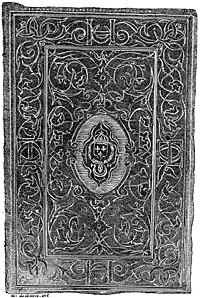
were discovered in the National Library of Paris. The board thus formed was covered indifferently with sheepskin, parchment, calf, morocco, or goatskin ; the books were sewn on raised or sunk bands, according to the owner's taste ; the edges were gilt, sometimes gauffered, and designs often impressed upon them to match those of the sides. In large folios wooden boards were still used, more solid, and protected from rubbing by nails in relief. But the inside of the cover was as yet only covered with paper. Leather linings were very uncommon.
The reign of Henri II. increased yet more the importance of bindings ; it was the time when Grolier collected, and clever artists came from all parts. Geoffroy Tory had given the best models for letters and interlacings. The Queen, Catherine, derived from her parents the taste for decoration in gold and colours, and patronised the artists called by her from the court of Florence ; and the favourite, Diane de Poitiers, Duchess of Valentinois, rivalled her in luxury and expenditure. Henri II. in the decoration of his castles, as well as his books, introduced equivocal emblems, of which the signification may be doubtful, but those of his mistress may be recognised, not those of the legitimate Queen. He interlaced two reversed "D's" by an " H," in the form shown in the border on the preceding page. Strictly speaking, we ought to see there two "C's" back to back ; but as we find the "D" on all the bindings displaying the arms of Diana, there can be no doubt, and Queen Catherine doubted less than anybody. Other emblems of Diana are to be found in the arcs and crescents that are plentifully displayed. The library of Diana was
/ BINDINGS OF HENRI II. p.271 /
large, owing to the King not hesitating to take valuable
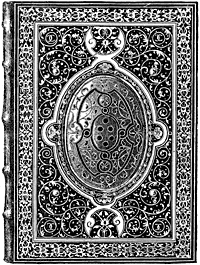
books from the public collections for her. Two centuries after her death it was dispersed, and the greater part of / p.272 / the books belonging to the national collections were restored on the deaths of those who then purchased them. Hence the largest number of the bindings of Henri II. and Diana of Poitiers will be found in the National Library of Paris.
Queen Catherine also had special patterns with a monogram identical with the double "D" mentioned above, but the branches of the "C" were a little longer than the branches of the "H ;" she also used a "K" on the sides of her books. The specimen which we reproduce is a purely Italian work.
From kings and queens the fashion passed to the great lords, it having come to the kings and queens from a private individual. The Constable Anne de Montmorency adorned his bindings with a cross and spread eagle. Among the amateurs of binding of the sixteenth, seventeenth, and eighteenth centuries using distinctive marks, we may mention Philip Desportes, the poet, who used two Φ enlaced, as did also Superintendent Fouquet in the seventeenth century. The brothers Dupuy adopted the double Δ, arranged as a star. Colbert had a curled snake (coluber for Colbert !), the Gondis two masses of arms, Madame de Pompadour three towers, etc. Fouquet beside the Φ used a squirrel on some of his bindings.
In Germany, Count Mansfeldt adopted the ornamental style with arms, of which a specimen is here given ; and Marc Laurin de Watervliet also decorated and dedicated his books to his friends, using the motto " Virtus in arduo." Among the lords of the French courts who favoured polychromatic ornament and bold compositions were the young Valois, Louis de Sainte
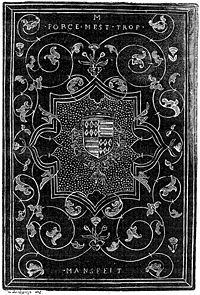
Maure, Marquis of Nesle, and Henri de Guise, called "Le balafré."
Charles IX. had his emblems and devices, the double "C" crowned the legend "Pietate et justitia," but his brother, Henri III., loved the decoration of books more than he did. The passion of the King for miniatures which he cut out of books is known ; this passion for golden things he repeated on bindings, for which he chose special designs. Henri III. was an amateur of dances of death ; he visited cemeteries, attended funerals, and took a death's-head for his emblem. This emblem was not his invention ; long before him Marot had addressed an epigram to a lady in which he brought love and death into close conjunction. However that may be, the King chose skeletons and penitents' tears to ornament his books. He also tolerated diamonds, although he absolutely prohibited them in the clothing of ladies or fixed the number pro rata with the rank of the authorised person. There was in this prince a singular mixture of taste and artistic acuteness by the side of a mania or hallucination which was reflected on the most intimate objects of his apparel or of his furniture. Thus if we find, at the end of the sixteenth century, a death's-head on the sides or the back of a volume, the binding is of the period of Henri III.
The binders of his time are known by the mention that is made of them in the royal accounts ; the Eves were the most celebrated among all of them. Nicholas Eve was charged with the binding of the Statutes of the Order of St. Esprit, with which the King gratified his friends. Mention of this work is found in the Clairambault manuscripts, where we read, "To Nicholas Eve,
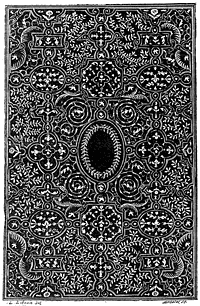
washer and binder of books and bookseller to the King, forty-seven and a half escus for washing, gilding, and squaring the edges of forty-two books of statutes and ordinances of the Order, bound and covered with orange Levant morocco, enriched on one side with the arms of the King, fully gilt, and on the other of France and Poland, with monograms at the four corners, and the rest flames, with orange and blue ribbons," etc.
Louise de Lorraine, wife of Henri III., counted for little in the life of her husband ; nevertheless she had a certain number of books decorated with their united escutcheons.
The bindings attributed to Eve were decorated all over the sides and back with interlacing patterns of geometrical character, the spaces between the parallel lines and in the middle of the figures left at first quite blank, but afterwards filled in with palm branches and wreaths of foliage ; to these delicate and elaborate yet brilliant toolings have been given the name of bindings à la fanfare. This designation requires explanation, and is a good example of the grotesque style adopted by modern amateurs in their appellations.
The fine work of that time prepared for the coming in the seventeenth century—about 1620—of the works of Le Gascon, or at least for the artist with whom in our days are connected the works of the reign of Louis XIII. Under Henri IV. the fleur-de-lys occupied most of the covers of the royal books, from vellum to Levant morocco ; works in this class had nothing very remarkable. The first years of Louis XIII. revealed a new process, inspired by the Eves. Le Gascon embroidered delightfully on the fanfare ornaments;
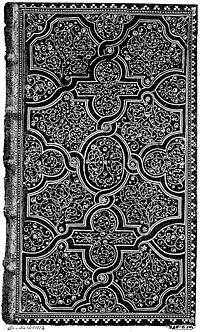
showing the fibres of the leaves, he made a new kind of ornament, consisting of minute gold dots elaborated into lines and curves of singular brilliancy and elegance. Of this style, called pointillé, we give a specimen from the collection of M. Dutuit. The fashion had arrived all at once ; lace, banished from clothing by severe edicts, found a refuge on the covering of books.
The times were hard then for binders ; they were constrained to live in the university and to employ only its workmen. A binder was never his own gilder ; he employed the gaufreurs of shoe-leather, more expert and bolder, to gild his leather. Among these artisans was one named Pigorreau, whom the edict found living in the midst of publishers and working for them ; he was compelled to choose either to remain bootmaker or become bookseller ; he chose the latter, against the syndics of the trade, against every one, and he made enemies for himself. He revenged himself by turning the masters into ridicule in a placard.
Le Gascon was probably the assumed name of an artist in this style. The Guirlande de Julie, worked by him for Mademoiselle de Rambouillet, gave him great honour in the special circle of this little literary court. It was the fashion then for poor authors to put a fine covering on their works and to offer them to the great for their own profit. Tallement des Reaux notably signalises the poet Laserre, who displayed his luxury in irreproachable bindings. And then the farmers of the revenue, successors of Grolier in financial trusts, formed libraries for pure fashion, never opening the volumes covered for them in sumptuous attire. If we may believe Sauval, author of the
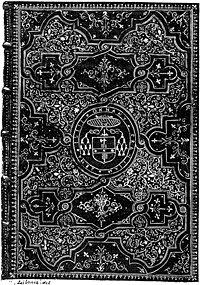
Antiquités de Paris, they went further, and on covers without books inscribed imaginary titles and fantastic / p.280 / squibs to mislead their visitors. The bookcase being carefully closed, it was difficult to discover the imposition. Sauval writes, "In place of books, they are content with covers of levant morocco, on the backs of which, in gold letters, are inscribed the names of the most celebrated authors. A binder of the university assured me that not long since he and his confrères had made them for a single financier to the amount of 10,000 crowns !"
The works of Le Gascon will be found more among great personages than with the so-called collectors, which gives value to their grace and charm. The King's brother Gaston possessed them, then Mazarin, an example from whose library is here reproduced. On this binding Le Gascon worked gilt compartments and elaborate arabesques ; in the middle of the sides are the arms of the Cardinal and his pretentious device : "Arma Julii ornant Franciam !"—"The arms of Jules the ornament of France !" In spite of the profusion of subjects, nothing could better please the eye or indicate a man of taste.
But if Le Gascon be a legendary personage, he had an imitator or rival, very near to him, named Florimond Badier, whose works had at least the advantage of being signed. At the bottom of the inside cover of an inlaid morocco binding in the National Library at Paris is the inscription " Florimond Badier fec., inv." The analogy between this work and those known as Le Gascon's is palpable ; inside and outside, the cover is stippled with small tools (au petit fer ) in the same manner. Florimond Badier was not appointed bookseller until 1645, and so could not have composed / BINDINGS FOR LOUIS XIV. p.281 / earlier bindings attributed to Le Gascon, but this resemblance of style evidences the existence of a Parisian school, the adepts of which copied one another, as they do nowadays.
The work was soon simplified ; pallets and wheel-shaped tools were invented to produce that which was improperly called dentelle ; this mechanical work was done by a wheel-shaped tool, previously heated, on gold in sized leaves, on which it impressed its projections.
With Louis XIV. the passion for gilding increased. Charming festoons were designed, but they were soon abused, and inundated the libraries. On the sides were seen rising suns, arms, and golden garlands. Cramoisy directed the royal bindings, the King having devoted large sums to the purchase of Levant leathers. In 1666 the Director of Works ordered red moroccos ; in 1667 he received twenty-two dozen skins, amounting, with the expenses of transport, to 1,020 livres tournois. Successive supplies were made, and were used for the royal library, sixty-nine dozen in 1667, forty-six dozen in 1668, and three hundred and thirty-three dozen in 1670, costing the King more than 12,000 livres. On these admirably dressed skins, which, in spite of incessant use, still remain now as in their first days, the King caused to be applied, according to the size, tools of borders, having in the middle the arms of France, with the collar of St. Esprit.
Among the binders mentioned in the very useful work of M. J. J. Guiffrey on the expenditure of Louis XIV., we find Gilles Dubois, who died before 1670 ; Levasseur, binder of Huet, Bishop of Avranches ; La Tour, Mérins or Mérius, who died before 1676 ; and also / p.282 / Ruette, the reputed inventor of marbled paper for fly-leaves of books : to him the bindings of the Chancellor de Séguier, with their ornament of the golden fleece, and of Madame de Séguier, are attributed. It was probably these men who decorated the books of the brothers Dupuy, Fouquet, and Colbert, marvellous works of solidity, if not always of elegance, which have resisted all assaults. Unhappily, in many instances the mechanical dentelle overburdened the work, and gave it a commonplace regularity. In the Condé, Colbert, and perhaps even Madame de Longueville's collections, there are many specimens of this kind with two or three filleted borders.
We have come to an epoch when the difficulties resulting from confusion between the booksellers' and binders' trades began to be understood. The revocation of the Edict of Nantes had implicitly prepared a crowd of measures and rules in all branches of national industry. It was a good occasion to prevent the artisans of binding unduly parading themselves as booksellers and selling merchandise of which they understood nothing ; Louis XIV. interfered, and separated the two communities. The binders then became the relieurs-doreurs of books ; they had their own organisation, but remained subject to the university ; the heads of the fraternity were called the " guards." The principal arrangements of the regulation of 1749 were : the members of the corporation had the sole right to bind books, from the elegant volume to registers of blank paper. Five years of apprenticeship and three of companionship were necessary to obtain the brevet of freedom and to hold a shop. Moreover, it was
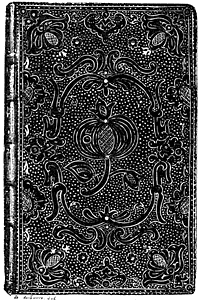
indispensable to read and write. One regulation ordained that the workman should be "able to bind and ornament ordinary books or others, to render them perfect and entire, to sew the sheets at most two together with thread and real bands, with joints of parchment, and not paper, and in case of infraction the said books were to be remade at the expense of the offender, who was besides condemned to a penalty of thirty livres for each volume." Their establishment was confined to the quarter from the Rue St. André des Arts to the Place Maubert ; they regulated the sale of calfskin and of tools ; in a word, they were surrounded by precautions by which the production remained always under the supervision of the masters and completely satisfied the client. This calculating policy was, in fact, a close imitation of the royal ordinance of 1686.
The mosaic bindings used from the end of the reign of Louis XIV. were an application of pared leathers of colours different from the background, pasted on to the side. The binders of the regency composed a great number, attributed now to Pasdeloup, as all the crayons of the sixteenth century are called Clouets, and all the panels on wood Holbeins. It is not that there was great originality in these works, or a particular art ; more often the workman did no more than transcribe Le Gascon or Eve or the older binders, and accommodated the processes of these artists to the fashion of his time. In this style we may cite the Spaccio de la Bestia Trionfante, printed at Paris 1584, for which the binder designed a cover of doubtful taste and, above all, an undeniable want of proportion. The
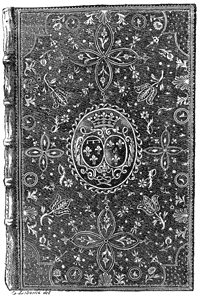
tendency was then to flowers occupying three-fourths of the page, to compartments too large, to open pomegranates, like the Spaccio here reproduced. If Pasdeloup had discovered these mediocre combinations, he could not be proclaimed the regenerator of a fallen art. The bastard style of these works may be compared to their mosaics, constructed of pieces ; it is a little of everything, and together it is nothing. However, in the midst of the quantity of mediocre things, some pleasing decoration is from time to time met with ; the design of a volume with the arms of the Regent and his wife, Mademoiselle de Blois, wants neither elegance nor taste ; without being perfection, it has better proportion and balance.
We should, however, hesitate to give names to all these works. Besides Pasdeloup, there were the Deromes, abandoning a little the mosaics, devising flowers and dentelles in combination, and no longer the simple products of the fillet. They formed a dynasty ; and if the Pasdeloups were at least twelve, there were fourteen Deromes all booksellers and binders from the reign of Louis XIV. The most celebrated was James Anthony, who died in 1761.
Peter Paul Dubuisson was not only a binder ; he was a designer. He invented heraldic ornaments, and composed models of gilding tools, in which his contemporaries emulated him. He was intimate with the delicate vignettist Eisen, and the counsels of an artist of this value could not but be useful to him. It is an extraordinary thing that in this world of celebrated printers, amateur financiers, and notable painters and engravers, not a single man can be met to give a real
/ DEROME AND HIS SUCCESSORS. p.287 /
impulse to the art of which we speak, and to prevent the dull continuance of experiments on the whole so poor. Doubtless the dentelles of Derome had a certain air of gaiety, to which the books of the eighteenth century accommodated themselves perfectly ; the tools of Dubuisson produce most pleasing designs ; but the old, the great binders, had altogether disappeared.
Besides, Derome massacred without pity the rarest works. He loved edges very regularly cut, and he did not fail to hew down margins opposed to his taste. He sawed books as well ; that is to say, in place of sewing the sheets on to projecting bands, he made a groove in the back, in which the cord was embedded. The books have no resistance.
To these celebrated names of French binders of the eighteenth century we may add Le Monnier, who worked for the Orleans princes ; Tessier, his successor ; Laferté, who decorated the small volumes of the Duc de la Vallière as Chamot covered the large ones ; in 1766 Chamot was royal binder. There was also Pierre Engerrand, then Biziaux, an original, who worked for Madame de Pompadour and Beaumarchais. Boyet, or Boyer, worked (1670–80) in the style of Le Gascon, with the same minute tooling, but simpler in character. Duseuil put very elaborate and delicate tooling on his covers from about 1710 to 1720.
The Revolution effaced many of the fine works which displayed the symbols "of a royalty justly detested," and Mercier wrote certain wicked little poems against binding. Lesné was the poet of book-binding, and he invented the process of plain calf without boards. Certainly from Grolier to Lesné there / p.288 / were numerous changes, so numerous that, in spite of the nude calf, it may be said that the art was nearly dead. In our days it has a little recovered. Amateurs have found new names, and often artists, to patronise : Trautz-Bauzonnet, Capé, Duru, Lortic, Marius Michel, in France ; Bedford, Rivière, Zaehnsdorf, Pratt, in England ; Matthews, Bradstreet, Smith, in the United States ; and many others. Unhappily, fortune does not permit every one to furnish his library luxuriously ; the true connoisseur searches rather for Groliers, Eves, and Le Gascons, than concerns himself about modern workmanship. Whatever may be its value, it is only fit to clothe the works of the time. A book published by Lemerre and bound by Petit is in true character, but a fifteenth or sixteenth century book passed under the hands of Trautz-Bauzonnet himself will be very much like an ancient enamel in a modern frame newly gilt.
Bookbinding in England has, with very few exceptions, never attained the artistic excellence reached in France. From the earliest times to the present day servile imitations of foreign work only are seen. The one purely original English binder is Roger Payne, who from about 1770 worked for thirty or forty years in London, performing with his own hands every stage of the work, even to cutting his own tools. The result was good, solid work, with perfectly original and often very beautiful decoration, appropriate to the character of the work itself. His favourite style was drooping lines of leaf ornaments in the borders and geometrical patterns in small tools. After him came Charles Lewis, who was an artist in the true sense of the word, and, coming down to our own time, Francis Bedford, who,
/ BINDING FOR THE TRADE. p.289 /
never pretending to originality, copied the best designs of the old French and Italian binders. His full calf books, with handsomely tooled backs, are models of solidity and taste ; and his decorations on the sides of morocco-bound books are always in good taste, and often of great elegance. The binders of the present day, perhaps for lack of patronage, seem to have abandoned originality ; and although much excellent work is done, it is no more than a copy of the Eves, Le Gascon, Derome, and the older artists.
Parallel with the luxurious bindings with which we have been exclusively occupied, there has always been the commercial work, prepared in advance. Liturgical works, above all, are sold in this form. Books intended for Grolier or other grand personages had their covers decorated au petit fer, and presented the result of the manual labour of skilled artists ; but for these a pattern was engraved in relief, leaving nothing to the caprice of the artist, and it was mechanically impressed on the side. This process is termed blocking. It was principally used in Germany, but Vostre, Verard, and Tory employed the same means. Even the interlacings and the capricious arabesques of Grolier were imitated by means of a fixed plate, parts of which were finished by hand to make it appear a complete work of imagination and handicraft. *
